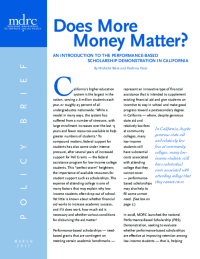Does More Money Matter?
An Introduction to the Performance-Based Scholarship Demonstration in California
California’s higher education system is the largest in the nation, serving 2.6 million students each year, or roughly 25 percent of all undergraduates nationwide. While a model in many ways, the system has suffered from a number of stressors, with large enrollment increases over the last 15 years and fewer resources available to help greater numbers of students. To compound matters, federal support for students has also come under intense pressure, after several years of increased support for Pell Grants — the federal assistance program for low-income college students. This "perfect storm" heightens the importance of available resources for student support such as scholarships. The expense of attending college is one of many factors that may explain why low-income students often drop out of school. Yet little is known about whether financial aid works to increase academic success, and if it does work, how much aid is necessary and whether various conditions for disbursing the aid matter.
Performance-based scholarships — need-based grants that are contingent on meeting certain academic benchmarks — represent an innovative type of financial assistance that is intended to supplement existing financial aid and give students an incentive to stay in school and make good progress toward a postsecondary degree. In California — where, despite generous state aid and relatively low fees at community colleges, many low-income students still have substantial costs associated with attending college that they cannot cover — performance-based scholarships may also help to fill some unmet need.
In 2008, MDRC launched the national Performance-Based Scholarship (PBS) Demonstration, seeking to evaluate whether performance-based scholarships are effective at improving retention among low-income students — that is, helping them persist in their studies — in different geographical locations with different amounts of monies over different durations. Performance-based scholarships are paid to students in addition to federal and state aid to further assist them with meeting the costs associated with attending college. These scholarships incorporate three key principles:
- They are predicated on students meeting basic conditions regarding enrollment and grades in college courses, unlike merit aid, which tends to be tied to high school performance.
- They are paid directly to students rather than to institutions, in order for students to "feel" the incentive and use the money in any way that will help them succeed academically (for example, to pay for books, supplies, reducing hours at a job, and so forth).
- They supplement federal Pell Grants and state aid to help meet the needs of low-income students.
This brief provides an overview of the program that was implemented in California — one of six such programs in the PBS Demonstration. All six programs are being evaluated using a random assignment experimental design, in which students are randomly assigned either to a program group that receives a scholarship or to a control group that does not receive a scholarship. In the California case, the random assignment process assigned sample members to one of six possible scholarship types, five of which are performance-based and one that has no performance incentive attached to it, or to a control group that did not receive a scholarship from the program. All groups continued to receive other financial aid and scholarships for which they qualified.






